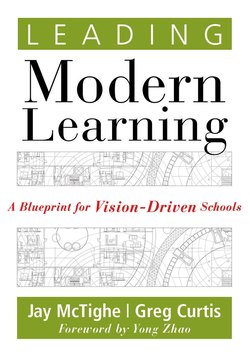Читать книгу Leading Modern Learning - Jay McTighe - Страница 10
На сайте Литреса книга снята с продажи.
ОглавлениеForeword
By Yong Zhao
The 21st century was once the distant future. Hence 21st century used to be a popular phrase for marketing products, ideas, and policies by evoking hopes and fears that may eventually exist. As a result, 21st century education has become a vision that compels bold actions—actions that ensure a safe departure from the past and guarantee success in the future.
The 21st century has arrived. The once-distant future has become our reality. While 21st century education has gained a diverse set of definitions that transcend the scientific meaning of 21st century as simply a reference of time, conversations about 21st century education can no longer be futuristic, driven by bold claims, fanciful imaginations, or fearmongering rhetoric. It is no longer meaningful to argue why we need or why we do not need 21st century education, nor is it productive to continue the debate over how 21st century education may differ from the education in the 20th, 19th, or 15th century.
It is time that we delivered a modern education that both meets the challenges and takes advantage of the realities of the 21st century. However, this is not an easy task, because while we are living in the 21st century, the institution of education started in the 19th or 20th century. It was built to meet the challenges of the past. It was built with the resources we had before. And once it was built, society spent the last century perfecting it. As Winston Churchill said, “we shape our buildings; thereafter they shape us”—the already-built institution has shaped our education mindset.
This mindset accompanied us into the 21st century. It continues as a persistent force that shapes our views and defines our actions in education. In essence, we are prisoners of the past. To create a modern institution of education, we have to escape from the past first. We have to look at education with a fresh perspective, a new mindset. This new mindset must be grounded in today’s realities, yesterday’s lessons, and tomorrow’s possibilities. The new education must start with the most recent discoveries about human beings: why they learn, how they learn, and where they learn. It must take into consideration the resources we have, all the learning opportunities we can harness in a globally connected society. It must also consider new outcomes—people not only able to cope with the 21st century but also able to create a better future for all.
However, we cannot flip a switch and change our mindset instantly. It takes time to change. But just spending time waiting for the arrival of a new mindset also does not work. We need to engage in real actions that are neither random nor sporadic. They need to be well-organized, carefully designed, and deliberately planned. They also need to be understood and undertaken by all members of an education community. For this to happen, we need a blueprint, just like the blueprints that architects create to guide the construction of modern buildings. This is just what Jay McTighe and Greg Curtis offer in this text: a blueprint for modernizing education.
Jay and Greg present a design process schools can follow to redesign education for 21st century learning. The process guides schools to engage in strategic moves that can ultimately lead to a new type of education needed for the 21st century. From vision to mission and from mission to action, Jay and Greg lay out a systematic process of redesigning schools with abundant evidence, proven strategies, and practical tools.
To be sure, this is not the first book I have seen that claims to provide practical guidance to education redesign. I have seen plenty of “blueprints” in education, and not all are equal; they can be good or bad. What makes me think this is a good blueprint is much more than the extensive practical strategies and actions. It is the sound research base behind the suggested strategies and actions and the ambitious goals these strategies and actions can help achieve. But most important, it is the bridge Jay and Greg build between distant, abstract, and grand ambitions and present, immediate, and small steps. They make the daunting task of designing a brand-new education achievable. It gives me, and all who desire a better education, confidence.
A blueprint can run the danger of being overly prescriptive and imposing a uniform view. As we know too well, educational institutions differ a great deal, as do people’s views of what constitutes 21st century education—outcomes, processes, institutional structures, students’ experiences, and pedagogy. For example, while I agree with Jay and Greg, I do think education should push even further in the areas of student autonomy and personalization as well as turning schools into global campuses. Still, Jay and Greg deal with these issues masterfully. While they have their version of a curriculum blueprint, assessment framework, and pedagogical approach for the 21st century, they do not impose them. I treat them as examples rather than as prescriptions. The process they suggest is about helping each school develop its own vision and mission. It is about schools working out strategies and actions of their own.
Education is in the futures business in that it is responsible for preparing students to live successfully in the future; however success is defined. But it should not be about preparing them to cope with the future or simply wait for the arrival of the future. It should be preparing them to proactively create their future. To train future-creators, we need future-oriented educational institutions, which are drastically different from institutions of the past and present. To create future-oriented educational institutions, we need to have a process, a plan, and a set of tools. This book offers such a blueprint and an excellent one at that.
